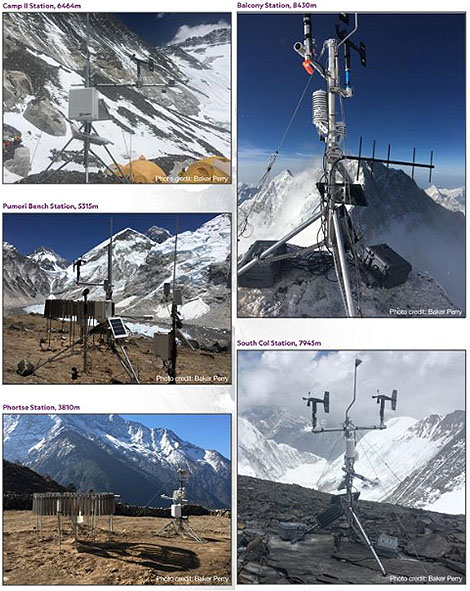
Despite freezing temperatures, snow is melting on Mount Everest. That’s just one finding in a recent study of weather data provided by a new network of five automated weather stations on Earth’s tallest mountain. The network includes two of the highest altitude weather stations on Earth, Balcony Station at 8,430 m (~27,658 ft) and South Col at 7,945 m (~26,066 ft), and offers “an unrivaled natural platform for measuring ongoing climate change across the full elevation range of Asia’s water towers,” Tom Matthews and his colleagues write in their new article published as an Early Online Release in the Bulletin of the American Meteorological Society.

The snowmelt is attributed to extreme insolation in the high altitudes of the Himalaya. It enables “considerable” melt up to Camp II at an altitude of 6,464 m (~21,207 ft), “despite freezing air temperatures,” the study reports. And modeling with the data the five stations are providing shows not only is melting occurring at South Col even with average air temperatures of -10°C—which means melting may be common at the tops of all but a small portion of the peaks in the Himalaya—but also is likely happening even at Everest’s peak, Matthews and his team report.
Uncertainties in the extrapolation are considerable, but we cannot rule out that limited melting during the monsoon may be occurring at the summit.
The authors note that while snow melting at the peak of the world’s tallest mountain may be “symbolic” as Earth continues to warm, sublimation of the snowpack appears to be a far greater contributor to its loss at such high altitudes. This finding has implications for the amount of snow that actually falls at extreme altitudes:
The amount of mass potentially lost by sublimation on the upper slopes of Everest, coupled with the presence of permanent snow cover over much of this terrain, raises the interesting prospect that snowfall at such altitudes in the Himalaya may be more substantial than previously thought. For example, the modeled sublimation of 128 mm at the South Col (in five months) is almost eight times greater than the predicted annual precipitation at such altitude. Windblown snow from lower elevations may account for much of the discrepancy, but the winds are also known to deflate the snow on Everest, sometimes to spectacular effect. Future work is clearly needed to rule out the possibility of a much more vigorous hydrological cycle at these extreme elevations.
Matthews and his coauthors conclude that the data the five AWSs have collected so far offer “rich opportunities” to adjust and improve mountain weather forecasting and melt modeling.